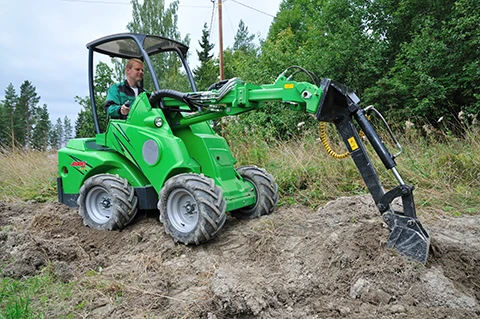Introduksjon til Avant 420: En Ny Æra av Kompakt Effektivitet
I en verden hvor effektivitet og allsidighet blir stadig viktigere, fremstår Avant 420 som en banebrytende løsning innenfor kompaktmaskiner. Denne innovative redskapsbæreren er designet for å håndtere et bredt spekter av oppgaver med imponerende smidighet og kraft. Enten du opererer innenfor hagearbeid, landbruk, bygg og anlegg, eller eiendomsvedlikehold, tilbyr Avant 420 en unik kombinasjon av kompakt design og robust ytelse som kan transformere måten du arbeider på.
Denne omfattende guiden vil dykke dypt inn i alle aspekter av Avant 420. Vi vil utforske dens nøkkelfunksjoner, tekniske spesifikasjoner, de mange fordelene den tilbyr, og de utallige bruksområdene som gjør den til en uvurderlig ressurs. Vårt mål er å gi deg en detaljert forståelse av hvorfor Avant 420 ikke bare er en maskin, men en investering i økt produktivitet og effektivitet.
De Unike Egenskapene som Definerer Avant 420
Avant 420 skiller seg fra mengden av kompaktmaskiner gjennom en rekke innovative egenskaper som er nøye utformet for å optimalisere ytelse og brukervennlighet. La oss se nærmere på noen av de mest fremtredende funksjonene:
Kompakt Design og Manøvrerbarhet
En av de største fordelene med Avant 420 er dens kompakte design. Med sine smale dimensjoner og lave vekt kan den enkelt navigere på trange områder hvor større maskiner ikke har tilgang. Dette gjør den ideell for arbeid i hager, parker, inne i bygninger og andre begrensede miljøer. Den enkle manøvreringen sikrer rask og effektiv utførelse av oppgaver uten unødvendig tidsbruk.
Kraftfull Ytelse i Kompakt Format
Til tross for sin beskjedne størrelse, leverer Avant 420 en imponerende kraft og ytelse. Den er utstyrt med en robust motor og et effektivt hydraulikksystem som gir tilstrekkelig kraft til å håndtere en rekke tunge oppgaver. Dette inkluderer løfting av materialer, graving, planering og drift av ulike redskaper.
Allsidighet gjennom Bredt Utvalg av Redskaper
Avant-systemets kanskje største styrke er det omfattende utvalget av tilgjengelige redskaper. Over 200 forskjellige redskaper er spesialdesignet for å fungere sømløst med Avant-maskinene, inkludert Avant 420. Dette gjør maskinen ekstremt allsidig og i stand til å utføre et bredt spekter av oppgaver med høy effektivitet. Fra skuffer og pallegafler til snøfresere og gressklippere, kan Avant 420 raskt tilpasses ulike behov.
Brukervennlighet og Ergonomi

Avant har lagt stor vekt på brukervennlighet og ergonomi i designet av Avant 420. Den intuitive betjeningen gjør at føreren raskt kan bli komfortabel med maskinen, noe som øker produktiviteten og reduserer tretthet. Det komfortable førermiljøet, med god sikt og lett tilgjengelige kontroller, bidrar til en optimal arbeidsopplevelse.
Sikkerhet i Fokus
Sikkerhet er en prioritert faktor i designet av Avant 420. Maskinen er utstyrt med flere sikkerhetsfunksjoner som beskytter både fører og omgivelsene. Dette inkluderer blant annet et stabilt chassis, sikkerhetsbøyle eller førerhus, og intuitive sikkerhetskontroller.
Tekniske Spesifikasjoner for Avant 420: Detaljert Oversikt
For å virkelig forstå kapasiteten til Avant 420, er det viktig å se nærmere på de tekniske spesifikasjonene. Disse gir et detaljert bilde av maskinens ytelse og dimensjoner:
Motor
Avant 420 er typisk utstyrt med en kraftig og pålitelig Kubota dieselmotor. Denne motoren er kjent for sin effektivitet og lange levetid. Spesifikasjonene kan variere noe avhengig av modell og produksjonsår, men vanlige kjennetegn inkluderer:
- Type: Kubota dieselmotor
- Effekt: Omtrent 14 kW (19 hk)
- Drivstoff: Diesel
- Kjølesystem: Væskekjølt
Hydraulikksystem
Det avanserte hydraulikksystemet er avgjørende for Avant 420s ytelse og evne til å drive ulike redskaper. Viktige aspekter inkluderer:
- Arbeidshydraulikk: Oljestrøm på omtrent 31 l/min
- Hydraulisk trykk: Omtrent 170 bar
- Hydraulisk motor til drift: Sikrer jevn og kraftfull fremdrift
Dimensjoner og Vekt
De kompakte dimensjonene er en av nøkkelstyrkene til Avant 420:
- Lengde: Omtrent 2190 mm (uten redskap)
- Bredde: Omtrent 1095 mm
- Høyde: Omtrent 1980 mm (med sikkerhetsbøyle)
- Vekt: Omtrent 1050 kg

Løftekapasitet og -høyde
Til tross for sin lette vekt, har Avant 420 en imponerende løftekapasitet:
- Maksimal løftekapasitet: Omtrent 550 kg
- Maksimal løftehøyde (til redskapens festepunkt): Omtrent 2820 mm
Kjøresystem
Avant 420 er utstyrt med et effektivt hydrostatisk kjøresystem:
- Type: Hydrostatisk firehjulsdrift
- Kjørehastighet: Omtrent 12 km/t (kan variere)
Styresystem
Maskinens styresystem bidrar til dens smidighet:
- Type: Leddstyring
- Styrevinkel: Omtrent +/- 40 grader
Dekk
Standard dekkdimensjoner kan variere, men typiske spesifikasjoner inkluderer:
- Standard dekk: 23×8.50-12
- Valgfrie dekk: Tilgjengelig for ulike underlag og bruksområder
.jpg)
Elektrisk System
- Spenning: 12 V
- Batteri: Med tilstrekkelig kapasitet for maskinens behov
Hydraulisk Oljetank
- Kapasitet: Omtrent 36 liter
Drivstofftank
- Kapasitet: Omtrent 20 liter
Fordelene med Avant 420: Hvorfor Velge Denne Kompaktmaskinen?
Det er mange gode grunner til å vurdere Avant 420 for dine prosjekter. Her er noen av de viktigste fordelene:
Ekstrem Allsidighet
Med over 200 tilgjengelige redskaper, kan Avant 420 tilpasses et utrolig bredt spekter av oppgaver. Dette eliminerer behovet for flere spesialmaskiner, noe som sparer både tid og penger.
Høy Effektivitet og Produktivitet
Den kombinerte kraften og manøvrerbarheten til Avant 420 gjør at oppgaver kan utføres raskere og mer effektivt. Dette øker produktiviteten og reduserer arbeidskostnadene.

Fremragende Manøvrerbarhet
Den kompakte størrelsen og leddstyringen gir Avant 420 en enestående manøvrerbarhet på trange steder. Dette er spesielt nyttig i hager, parker, og inne i bygninger.
Kostnadseffektivitet
Investeringen i én Avant 420 kan erstatte behovet for flere spesialmaskiner. Dette reduserer innkjøpskostnader, vedlikeholdskostnader og driftskostnader på lang sikt.
Brukervennlig Betjening
Den intuitive betjeningen og ergonomiske designen gjør Avant 420 enkel og komfortabel å bruke, selv for de som ikke har lang erfaring med maskiner.
Lavt Vedlikehold
Avant-maskinene er kjent for sin robuste konstruksjon og pålitelighet, noe som resulterer i lave vedlikeholdskostnader og minimal nedetid.
Miljøvennlig Alternativ
Moderne dieselmotorer, som de som brukes i Avant 420, er designet for å være mer drivstoffeffektive og ha lavere utslipp sammenlignet med eldre maskiner.
Høy Kvalitet og Lang Levetid
Avant er en anerkjent produsent kjent for sine høykvalitetsmaskiner. Avant 420 er bygget for å vare, noe som sikrer en god investering over tid.
Økt Sikkerhet
Med innebygde sikkerhetsfunksjoner og et stabilt design, bidrar Avant 420 til et tryggere arbeidsmiljø.
Bruksområder for Avant 420: Fra Hagearbeid til Industri
Allsidigheten til Avant 420 gjør den til en ideell maskin for en rekke forskjellige bruksområder:
Hagearbeid og Landskapspleie
I hagearbeid og landskapspleie er Avant 420 en uvurderlig hjelper. Med redskaper som gressklippere, jordfresere, hekksakser og løvblåsere, kan den håndtere alt fra plenpleie til planting og vedlikehold av grøntområder.
Landbruk
Selv om den er kompakt, kan Avant 420 utføre mange oppgaver på gården. Med redskaper som skuffer, pallegafler, rundballeklyper og gjødselspredere, kan den brukes til fôring, transport av materialer, rengjøring av fjøs og mye mer.
Bygg og Anlegg
På byggeplasser er Avant 420 en effektiv maskin for en rekke oppgaver, inkludert transport av materialer, graving av grøfter (med graveaggregat), planering av underlag og rydding av byggeavfall.
Eiendomsvedlikehold
For vedlikehold av private og kommersielle eiendommer er Avant 420 ideell for oppgaver som snørydding (med snøfreser eller snøskjær), strøing av salt eller sand, feiing av gårdsplasser og transport av utstyr.

Intern Logistikk og Lagerarbeid
Med redskaper som pallegafler og ulike typer transportcontainere, kan Avant 420 effektivisere intern logistikk og lagerarbeid ved å flytte varer og materialer raskt og sikkert på trange områder.
Rivningsarbeid (Lett)
Med spesialredskaper som hydrauliske hammere, kan Avant 420 også brukes til lettere rivningsarbeid innendørs eller på trange utendørsområder.
Skogbruk
Innenfor skogbruk kan Avant 420 brukes til lettere oppgaver som kvisting, transport av mindre tømmerstokker (med tømmerklo) og rydding av vegetasjon.
Kommunalteknikk
Kommuner og offentlige etater kan bruke Avant 420 til en rekke oppgaver, inkludert vedlikehold av parker og grøntområder, snørydding av fortau og sykkelstier, og transport av utstyr.
Utleie
På grunn av sin allsidighet og brukervennlighet er Avant 420 en populær maskin for utleie, og den dekker behovene til et bredt spekter av kunder.
Avant Redskaper og Tilbehør: Utvid Horisonten for Din 420
Det enorme utvalget av Avant redskaper og tilbehør er det som virkelig frigjør potensialet til Avant 420. Her er en oversikt over noen av de vanligste og mest nyttige redskapene:
Skuffer
Tilgjengelig i forskjellige størrelser og design for håndtering av alt fra løsmasse som sand og grus til snø og landbruksmaterialer.
Pallegafler
Essensielt for transport av palletert gods på byggeplasser, i lagerhaller og i landbruket.
Graveaggregat
For mindre gravearbeider, som grøfting for kabler eller rør, er graveaggregatet et praktisk redskap.
Jordfreser
Brukes for å løsne og bearbeide jorden før planting, ideelt for hagearbeid og landskapspleie.
.jpg)
Gressklippere
Tilgjengelig i ulike varianter for effektiv klipping av plener og større grøntområder.





